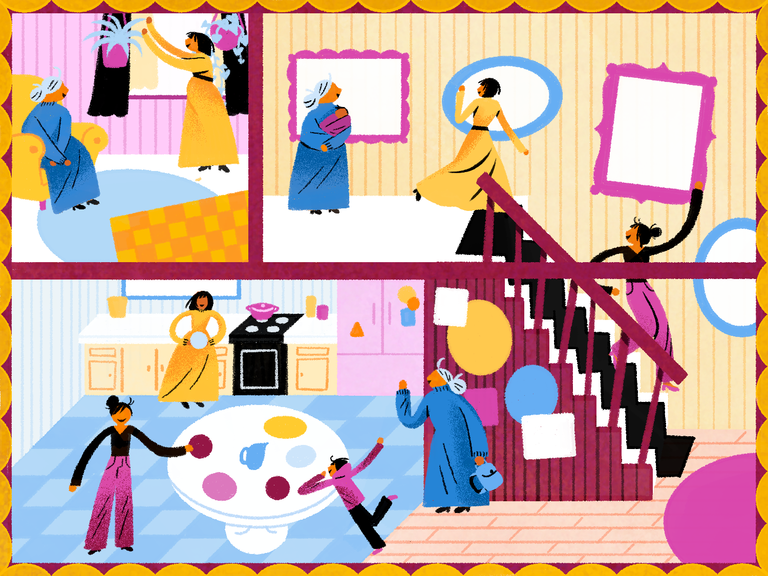What I Learned From Multigenerational Living

Skyrocketing rents, soaring mortgage rates, inflation and increasing loneliness. These are all factors that have affected various age groups, giving multigenerational living a fast-growing appeal (and rightfully so). While there are pros and cons to this lifestyle choice, it may come at a cost–as it did for me.
I was 34 years old and living with my husband in our one-bedroom high-rise building in the heart of New York City, when we found out we were expecting our first. As a child of immigrant parents, I clearly remember my upbringing in the suburbs of San Francisco, which was filled with backyard pool parties, frequent hangouts at the mall and after-school swim meets. My husband was born and raised in New York State and his folks later settled in Pennsylvania. While both sets of grandparents were stateside, they weren't easily accessible, which inspired some panic when I thought about the logistics of having a kid. I recall hearing about the astronomical costs of childcare, especially in a large metropolitan city, not to mention the increasing difficulty of finding quality childcare, but I never thought I'd be the one frantically searching for that.
My relationship with my family was a typical one as a daughter of immigrant parents. It was loving in the ways commonly known to many immigrant communities: Paying for my tutors, SAT prep courses, extracurricular musical lessons, tennis coaches, my university fees, along with the constant pressure of applying to premed programs at prestigious universities. Otherwise, my childhood was great in that my sister and I would ride bikes at the park on weekdays, rent books at the library on Saturdays, and play at the beach on Sundays.
Beyond that, going to the movies, playing video games, or shopping without a purpose were all foreign to me. In my younger years, I don't remember many playdates or being around many other kids. Since both of my parents worked a lot, I was in school aftercare and did not usually get home until dinnertime- which meant I only had time to eat dinner, do homework, and get ready for bed. There was no time for playing with friends in the neighborhood or watching TV, as that was not part of my parent's vision of my educational growth. I remember when my friends all became Girl Scouts, I was insanely jealous and always wondered why my mother never let me join. Well, it cost money and it was more effort than the life lessons I'd receive in return, so the answer was no. All of my friends shopped at Nordstrom, while my mother took me shopping at Nordstrom Rack, but in the clearance section. At the time, I didn't understand why I shopped at discount places and why I was not allowed to buy things at full retail price. She would tell me that everything had to be on sale for it to have value.
There were recycled restaurant to-go containers in our unused dishwasher and a variety of condiment packets in the cabinet from random restaurants. My parents saved every single plastic grocery bag, as it always had a second life as a trash bag, and don't even get me started on how rare it was to turn on the television set. (I recall the remote control was still wrapped in plastic.) When towels were too worn or socks had too many holes, they gained another purpose as dust wipers for the floor. Swiffers were a frivolous contraption because who needed that when you had a rogue sock and a pole? I never thought about ordering anything to drink other than tap water at a restaurant, because it was instilled in me that we were there to eat food not to fill up on lemonade and soda.
Don't get me wrong: my parents weren't cheap; they were frugal. Their philosophy was you spend money on necessities and luxuries come later. I never understood or appreciated the frugality of my parents' life choices, especially since I didn't have many other Chinese American friends. At the time, I just figured my parents were this way. They came to America with nothing and hoped to instill in me the values, hopes and dreams they shared by raising me with the strongest education and no desire for irrelevant things.
When I gave birth to my first child, my mother generously offered to stay with us in the city for a month. She'd help with the baby and household needs, and that would, in turn, give me time to recover. I accepted without hesitation because this help was invaluable, especially when quality childcare costs were through the roof. However, my husband and I were living in a one-bedroom apartment at the time. Three adults and a newborn infant really drove home the concept of "shoebox living."
I was in the thick of newborn mom life–so much so that I didn't notice my mother laying down her ways of living in our home: dimmer lighting, the dishwasher transforming into a storage cabinet, and more recurring themes from my childhood. As the days went on, it became hard to differentiate her role as my own mother, a doting new grandmother and the caretaker of my baby.
My mother would travel with us and be the biggest help, yet I was constantly walking on eggshells. I didn't know whether I should talk back if I disagreed about parenting tactics. I didn't know if I'd offended her by buying a latte when we had a perfectly good espresso machine at home. Let's just say, "treat yo self" isn't exactly written into the immigrant mentality. In the blink of an eye, three whole months had come and gone and so did the rollercoaster of emotions, tensions and differences in opinions on parenting and lifestyle choices–a small price to pay for unlimited childcare. When she left, my husband and I both felt a little heartbroken and lost as so many of her ways had left a positive impression.
The Pew Research Center reported that the number of people who live in multigenerational households quadrupled between 1971 and 2021, now representing 18% of the US population. That is around 66.7 million adults over the age of 18, or one in four Americans. According to Generations United, nearly six in 10 respondents (57%) said generations started living together because of the pandemic, and more than seven in 10 (72%) of those currently living in a multigenerational household plan to continue doing so long-term. Needless to say, multigenerational living is here to stay.
Post-pandemic, my husband and I moved down to South Florida, where we decided to build a four-bedroom home for the same monthly cost as our one-bedroom "shoebox" in NYC. Some of the models even had a casita option that created entirely separate living quarters, complete with a bedroom, kitchen and living room. With this much space, we had plenty of guest rooms, and with that, open arms for any childcare help offered our way. When my parents came to visit, it only made sense that they would make the six-hour cross-country flight to stay with us for entire seasons. Not only did they want to help, but this meant they would spend time with their only grandchild. For them, that was priceless. We graciously accepted the childcare help despite knowing that blending our households would be a challenge.
They say, "More money, more problems." In this case, the larger the house, the larger the issues. In our spacious new home, I found that Alexa was no longer responsive because my mother had unplugged all of my cords when they were "not in use." Forget the automatic lights that were set on timers. Out of respect for the way I was raised, I'd hesitate loading the dishwasher and using paper towels to dry my wet hands. Yet the longer my parents lived with us, I began to understand and appreciate their ways of thinking. I used to be a bit embarrassed of my frugality, but comedian Jimmy O Yang said it well: "People love to brag about how much money they spent buying something. Asian people on the other hand, like to brag about how much money they saved [on that same thing]."
Now that we had our growing little human in our lives, I struggled to maintain the ease of my daily life without upsetting her with my so-called Western lifestyle and parenting tactics. Raising my son with my parents by my side was bound to raise feelings from my own childhood. For example, I always knew my parents loved me, but I can still count the few times they actually spoke the words, "I love you."
When I married my husband, I learned that loading a dishwasher is an art form and that this miraculous machine wasn't solely for storage. I learned that being smothered in hugs and kisses and hugs wasn't a sign of weakness. I married into a large Irish Catholic family and physical affection was plentiful. My dad would remind me daily that I coddle my son too much. He'd even have conversations with him about how he should be stronger without relying on me. (He's five years old.) To be honest, I never understood the lack of physical affection prevalant across most Asian cultures, and one thing was certain: I knew that was not how I'd raise my kid.
There was a clash in parenting tactics. My parents didn't buy Western snacks, nor did they allow me and my sister to watch TV. That would create grimaces when they'd see my son indulging in goldfish crackers while playing on his iPad. (Not learning how to code.) I'd be slightly irritated, yet I'd stay silent when I heard my father lecture my son on how American kids consumed too many snacks over proper meals, and that all of the electronics were mushing his brain. I distanced myself whenever I felt my parenting was in question, lest I come off as ungrateful or disrespectful. Simply out of deference for the way my parents raised me, I rarely interjected, despite sharing a different parenting philosophy for my son.

I truly believe that my parents raised me in the best way that they knew. I'm doing the same with my son, but from the viewpoint of a different cultural generation and mindset. I did not grow up with gentle parenting; instead, I was faced with strict and rigid household rules. My mother questions why I allow my child to push back on my rules. My response is that I want open and honest communication with my son–something I feared doing as a kid and clearly, something I still find challenging today. I was raised with such high expectations, so much so that I constantly worried I was disappointing my parents. There were other things I wanted to do besides practice piano for three hours a day, or attend Chinese school every Saturday to learn Mandarin. I wanted to be at the mall with my friends, but I ended up just winning piano scholarships.
As a child of immigrants, I've dealt with an inherent need and pressure for approval from my parents. Of course, we've since moved on from SAT scores and report cards. The merging of two generations and two cultures within one space–multicultural and multigenerational living–requires a steep learning curve. As you can imagine, coexisting under one roof sometimes creates chaos. Feelings were unintentionally hurt, words were misunderstood, and actions couldn't be undone.
I always envisioned that being a grandparent came with its own set of perks: spoiling the grandchild and letting them get away with more than what the parents would allow. What I found that was my parents were like secondary parents to my child–enforcing rules much like how they did with me. Now that I have my own home with my own growing family–and with us all living under the same roof–I feel like I have something to prove to my mom and dad. A creeping familiar feeling that's been replaced with terrific report cards to having to meet their expectations as a parent.
While I have the utmost respect and gratitude for what my parents sacrificed for me, I've learned something valuable with multigenerational living: setting boundaries in how I care for my child and how I manage my home is the only way to peacefully coexist in the same household. My parents will always have their way of doing things and I am doing my best to explain my choices and decisions, so that we can build mutual understanding.
Of course, there's an upside to living in a multicultural and multigenerational home. The ability to build upon my parents' knowledge as well as their mistakes, while keeping so much of my culture alive, is also influencing how I raise my son. So what if I keep all the to-go containers? When they fly back, I can easily discard those plastic items. Yet I will keep, in safe storage and in my heart, the challenging moments that brought us all closer together and helped us grow.























